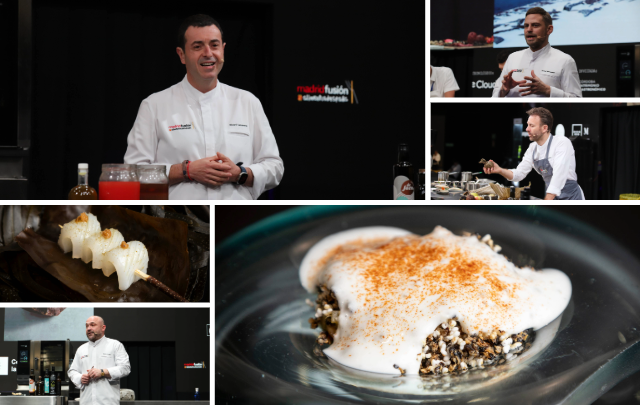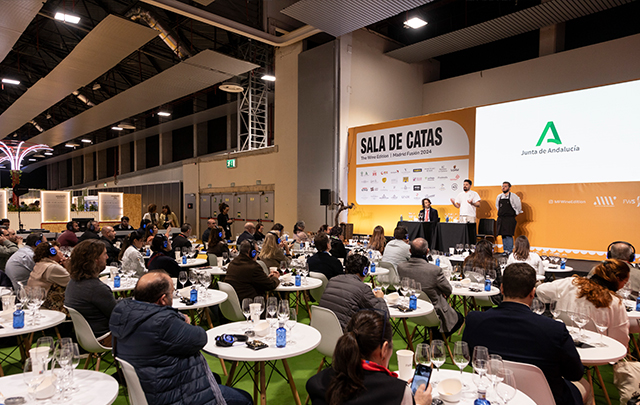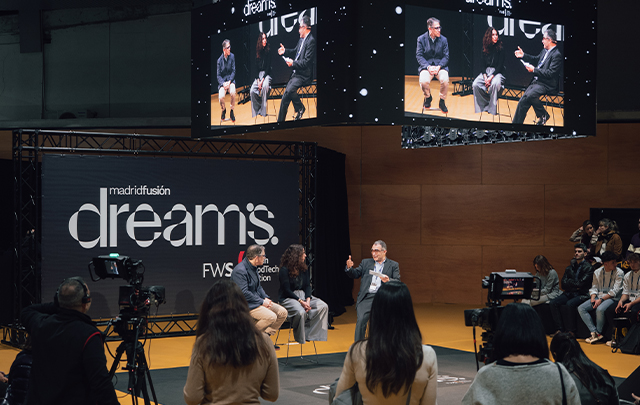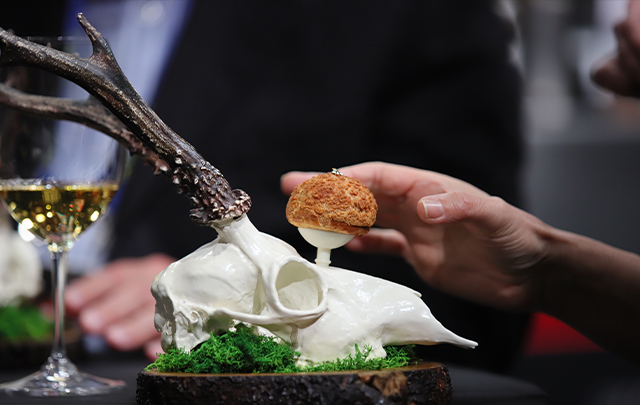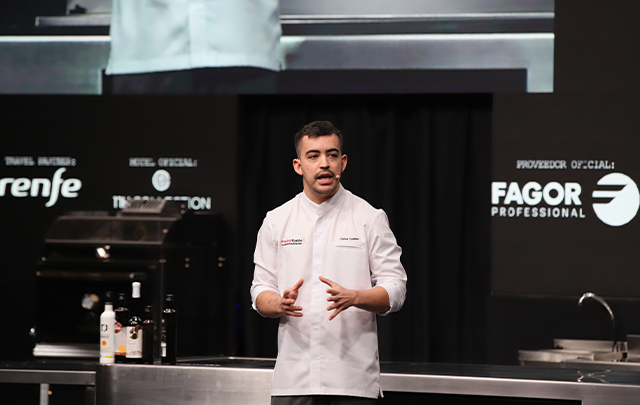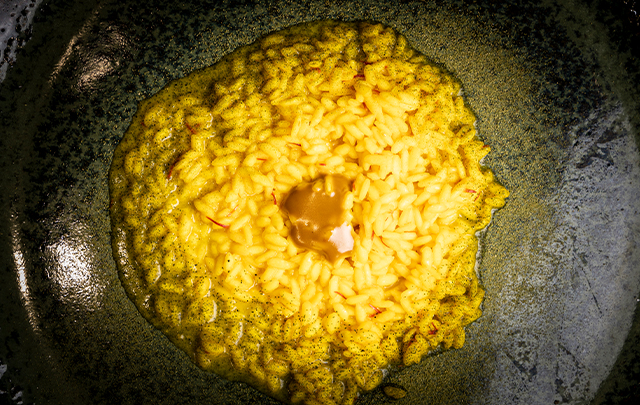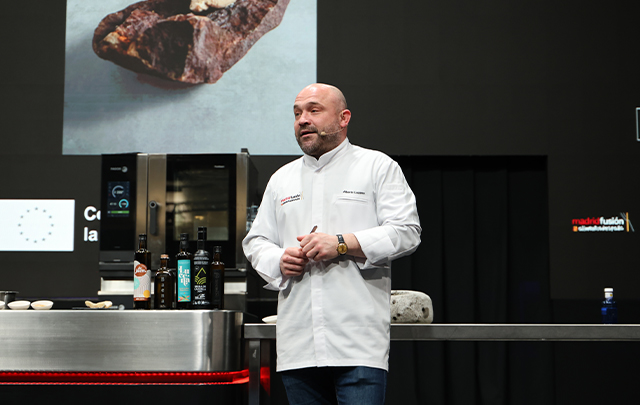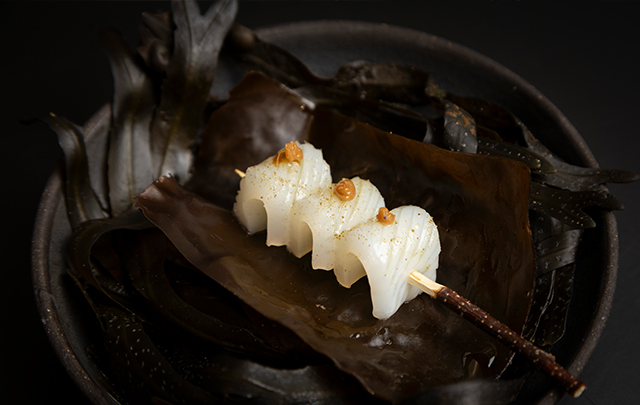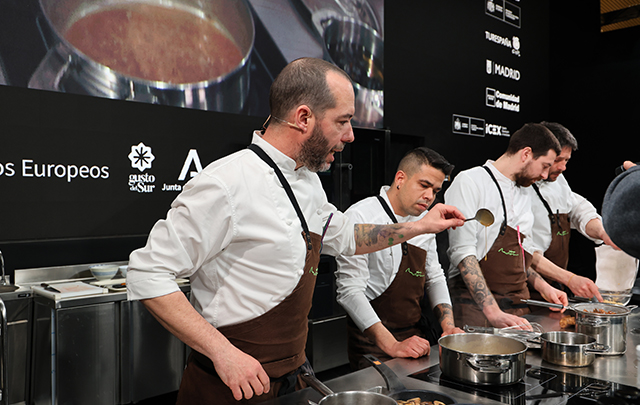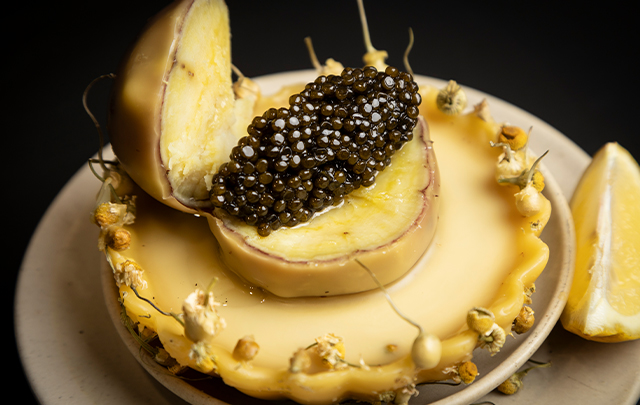News
The fourth edition of the International Wine Congress will be held at Ifema from January 29th to 31st
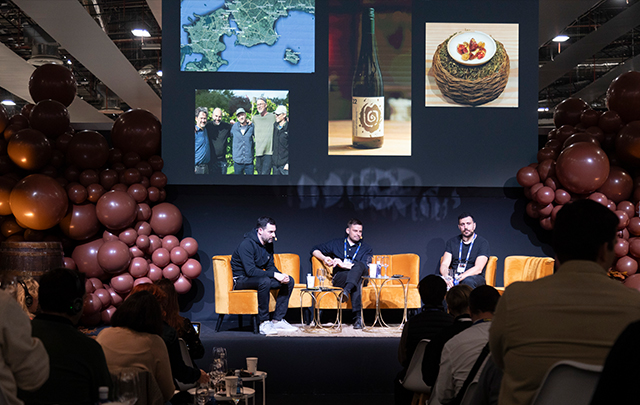
A journey to the flavours of ancient Rome, Nordic harmonies and tea as an alternative pairing, on the first day of Madrid Fusión The Wine Edition 2024
The former sommelier at elBulli and author of Sapiens del Vino, Ferran Centelles, opened the first day of Madrid Fusión The Wine Edition with a tour of the Ruta de la Plata by glass. A journey through Spanish history and geography, with gastronomic and wine-related stops that took participants back in time to Phoenician, pre-Roman, and Tartessian times.
In this sensory journey, Centelles relied on a unique combination of recipes inspired by ancient Rome, prepared by Carlos Casillas, chef at the Barro* restaurant, and some of the most special wines from wineries such as González Palacios (Seville), Fuentes del Silencio (León), and Rodríguez y Sanzo (Toro). Unique wines, old vintages and off-market editions from established producers, and new promises from national winemaking. "There are stories from the Romans about wines that are more than a hundred years old," said Casillas during the presentation. This argument was used to present the pairing of chestnuts with Frasquito Reserva en Rama from González Palacios (Lebrija), an unfiltered sherry from Seville, aged for 50 years under a veil of flowers in the criaderas y solera system. The second experience united Lusitanian and Roman territories with Arroyo del Cabrito 2022, from Castúo Wines (Extremadura), in the glass and unleavened acorn bread with goat and mulsum on the plate. A wine that presents the typical soils of Tierra de Barros (Badajoz), with clays and mica, made with a Portuguese grape variety and aged in used French oak barrels.
Tierras Extinta 2010, from Rodríguez y Sanzo (Toro), a blend of three old vines planted on ungrafted vines and fermented in wooden vats, and the blackberry and Zamorano cheese ravioli on the plate were the third suggestion. A tribute to transhumance as a nomadic way of life and survival in the Middle Ages. "Cheese and wool enriched the country and were the driving force behind the later transatlantic voyages and journeys to hitherto unknown lands," explained Ferran Centelles.
The fourth stop took us to Castilla y León, in the hands of Las Quintas 2016, from Fuentes del Silencio, a high-altitude mencía from the highest and coldest plots in the north of the Jamuz Valley. A unique, spicy wine that Carlos Casillas wanted to pair with a risotto of peppercorns and water pepper. A historical leap back to the 13th century and the hippocras pimenç, the most peculiar wine of the time, spicy and medicinal, which Centelles linked to the first use of pepper in Spanish cuisine, as an alternative to pepper. "Rome made Hispania for gold, the Industrial Revolution for coal, and wine is the liquid fruit of the earth," explains the author of Bullipedia. This last pairing is fully modern, with Albarín Blanco from Viñedos Singulares de Señorío de Ibias (D.O. Cangas), from a heroic vineyard and aged on the lees, and the Asturian stew prepared by the chef at Barro*, served in the form of a tapa.
At lunchtime, Álvaro Ribalta MW took to the stage at The Wine Edition Wines from Spain to talk about the presence of Spanish wines in London. Having lived in the English capital for fifteen years, the youngest Spanish Master of Wine and founder of the Massal Selection wine platform, offered the audience his extensive international experience and proven palate to review the wine sector in the UK, with a focus on the Spanish market. The expert laid out concepts of distribution channels and trade structure on this side of the pond, and concluded with a series of tips for wineries interested in succeeding in the UK market. "London has always been the nerve centre of wine education, it is a market with a long history, very old and very established," Ribalta explained. "It is the market that everyone wants to be in, but it is also the most difficult to penetrate because of the competition. In London, there are all kinds of wines, and the distribution channels are more complex; it is difficult to find a distributor who can give your product the attention it deserves".
The secondary market has developed more in the UK in recent years, particularly the fine wine market and auction houses. Stores, such as Tesco and Waitrose, lead the off-trade channel (wine shops and supermarkets), either through private labels or mid-priced wines. As for the on-trade (HORECA), the Master of Wine highlighted the scant presence of Spanish wines on UK wine lists. "There's usually some sherry, a couple of whites and a couple of reds, but Spanish sparkling wines, for example, usually don't have a place. The online segment in the UK is in the hands of Virgin Wines, Naked Wines and The Wine Society, while the secondary market is dominated by fine wine merchants such as Farr Vintners, Crump Richmond Shaw or Fine+Rare. "Prescribers like Wine Advocate, James Suckling or Jancis Robinson still have a lot of power and help us sell Spanish wine through these channels," Ribalta points out. "Luis Gutiérrez's work for the Parker Guide has helped raise awareness of other projects beyond Vega Sicilia," he added. "Another interesting sector that does not exist in Spain is that of auctions. In London, however, houses such as Christie's and Sotheby's auction Spanish lots alongside renowned wine unicorns.” The main dilemma, however, is still price. "There is a huge difference between the price of Spanish wines in the domestic market and the British market. The first reason is the price of land, which is much higher in the UK, and the second is the alcohol tax, which rises depending on the type of wine and alcohol content. All this, added to the sales margin and VAT, means that the final price is always much higher there," points out Álvaro Ribalta MW. So what are the opportunities for Spanish wineries in such a hostile environment, also affected by Brexit? "To do things well and not expect to sell a lot, but to be well positioned," the sommelier summed up. The Viñateros fair, which will take place in February, is one of the initiatives that make us believe that it is possible to enter the British market. Studying and understanding the market, applying specific sales techniques, modifying the price structure according to each sales channel, and thinking about positioning rather than volume are the recommendations of the Master of Wine.
The tea revolution: from terroir to wine pairing
"When Noma started using my teas and talking about origin and processing, it became a fundamental part of the menu, not at the end of the meal, but throughout the proposal". This is how Henrietta Lovell began her presentation on how tea can be a gastronomic alternative to develop the art of pairing, if the human component is taken into account.
Internationally known as the Rare Tea Lady, Lovell focused her TED Talk on chefs and sommeliers, the real "decision makers" in the hospitality industry. "Do you want to change your business and the world for the better? Do we have that power? Does it even matter?" The expert drew on an article published in the UK to talk about how tea can add real value without human cost. An overview of the positives and opportunities that tea can bring to the sector, inspired by the incredible customer experiences that the founder of the Rare Tea Company and Rare Charity has gathered throughout her career around the world. "There is no single type of tea in Darjeeling, just as there is no single type of wine in Rioja. Everything matters: the origin, the terroir, the sun, the minerality of the soil, the time of harvest… The difference between a tea or an industrial wine and something special lies in these details," he explains. And this can be a formula for enhancing the gastronomic experience. "If you do things with care, it becomes an extraordinary experience for the consumer and a way to engage chefs with this range of flavours. Consumers are changing, young people are travelling and they want to know the story behind the products. This is something that is appreciated not only in the world of wine, but also in the world of tea. Restaurants and hotels are looking to offer higher quality and experiences to match their culinary offerings when it comes to tea: "Why not spend the money on a nice bottle of tea?
Lovell's talk turned into an ecological plea, not only against environmentally damaging tea bags, but also against the human exploitation of a sector that is in the hands of the big tea companies: "There are 15 million people working in the tea sector in the world, more tea is drunk than wine, but the majority of these people are women farmers living in marginal communities," he explained. "The tea we drink here doesn't come from China or Japan, where the value of tea is much higher, but from Nepal, India, Kenya and places we can't imagine. Seven companies control the farms and the supply on this side of the world. The people who make tea for these tea giants work very hard and their life expectancy is just over 40 years. We have no responsibility for this because we don't know.
To change this reality, the founder of the Rare Tea Company continues, "all we have to do is ask ourselves where the tea we consume comes from, to take an interest in its history and production, to put on menus not only the type of tea but also the name of the farm, the taste, the tasting notes, as if it were a wine. People prefer quality to price.
A Vinomio with a Nordic flavour
The aim of the Vinomios is to give visibility to other types of cuisine, to democratise the sector and to highlight the versatility of all types of wine. The first of these was held this Monday and focused on Nordic pairings, drawing on the experience of Nicolai Nørregaard and Alberto Segade, chef and sommelier at Copenhagen's Kadeau restaurant. "We have two seasons and it is a challenge to completely change the menu twice a year," said Galician sommelier Alberto Segade during the tasting. "There are 17 dishes and we only have seven wines, so they all have to work with at least two dishes, which are also very different.
A twist on sulphites
Mohamed Benabdallah, sommelier at Asador Etxebarri** in Vizcaya, began the afternoon session in the auditorium of The Wine Edition Wines from Spain with one of the great dilemmas in wine today: the controversial use of sulphites. He did this through a masterful tasting that sought to answer the well-known question that gave the presentation its title: with or without sulphites? "It is said that without sulphites it is easier to harmonise dishes, but if the wine is not clean, it does not make things easier. The important thing is that the wine is clean," began Benabdallah. During a tasting of 8 wines paired (with and without sulphites), the sommelier highlighted the role of sustainability in natural winemaking and how the visual, aromatic and gustatory aspects affected by sulphites can affect the creation of pairings. "We are locked into rules that don't allow us to keep tasting and limit our ability to find new things, and this is especially the case with natural wines, because we are faced with two extremes: either very good things or less good things".
As for the dilemma of what natural wines really are, Mohamed Benabdallah was categorical: "Nobody can say what a natural wine is or how it is made, and that is a good thing because it is a way of making wine more accessible". However, the sommelier explained that natural wines require special care: "You have to pay attention to how they travel, how they are protected, where they come from, the temperature, because heat ferments the bottles".
During the tasting, the wines spoke for themselves. In some cases, the wines with sulphites showed a better organoleptic balance, while in others it was the wines with sulphites that pleased the participants the most. One of the main conclusions of the demonstration by the sommelier from Asador Etxebarri** was that natural wines age worse because they oxidise earlier, which is particularly noticeable in the lack of freshness of sparkling wines, although there are exceptions, such as certain reds.
Agustín Trapero closed the first day of the fourth edition of Madrid Fusión The Wine Edition by teaching participants how to work like the great wine professionals through a unique blind tasting. The former wine director of the Four Seasons Madrid 5* and founder of AT Somm, explained the role of a top sommelier and demonstrated the uniqueness and difficulty of the work of these great professionals through a technical tasting in which the participants had to identify the grape varieties and regions of the world from the glass without any information. "Master of Wine and Master Sommelier have the same parents, both diplomas come from a British organisation that rewards sommeliers who take these courses, but they are different", Trapero differentiated. In 1977, after a series of preliminary stages, the Court of Master Sommeliers began to be recognised throughout the world, and today, along with MW, they are the two qualifications with the most international weight. "They have a theory, they have standards, and you have to prepare according to those standards.”
Agustín Trapero's tasting with a corked bottle showed that the training of these professionals helps them to develop superior tasting techniques that move away from banal predictions to determine the area of production, the variety or the style of wine, always with full knowledge of the facts. For the rest of us mortals, blind tasting is nothing more than a humbling experience.
A tour of Spain's wine-producing regions in the tasting room Vinos de Tenerife inaugurated the Tasting Room at Madrid Fusión The Wine Edition 2024 on Monday with a tasting entitled "The diversity of Tenerife wines through their listanes". The presentation was attended by representatives from some of the Canary Islands' wine regions: Marián Fernández (D.O. Valle de La Orotava), Óscar Rodríguez (D.O. Valle de Güímar), María Paz Gil (D.O. Tacoronte-Acentejo), Aaarón Alfonso (D.O.P. Islas Canarias and D.O. Ycoden Daute Isora) and Trinidad Fumero (D.O. Abona). This was followed by a journey through the history of Alejairen (2007-2022) by Olga Fernández, director of Bodegas Familia Fernández Rivera, Lucía Pascual and Rodrigo Pons, winemakers and technical directors of the winery. Marqués de Cáceres took over this interactive space of Madrid Fusión The Wine Edition 2024 with the presentation of the Signature Wines. A versatile combination, a fusion of elegance and creativity, accompanied by Cristina Forner, Fernando Costa and Coco Montes.
Cordoba gave way to the gastronomic harmonies of Los Pedroches P.D.O. ham and Montilla and Moriles wines, coinciding with lunch. The tasting was led by Enrique Garrido Giménez (Director of the CRDOP Montilla-Moriles) and Juan Luis Ortiz Pérez (Secretary General of the CRDOP Los Pedroches). Mireia Torres, director of Jean Leon, and sommelier Sergi Castro presented the winery's territorial innovations in the early afternoon. And to close the first day of the Tasting Room, Jaime Suárez, winemaker at Bodegas Dominio de Atauta, led a journey through the history of this unique valley through the Single Vineyards Collection.

